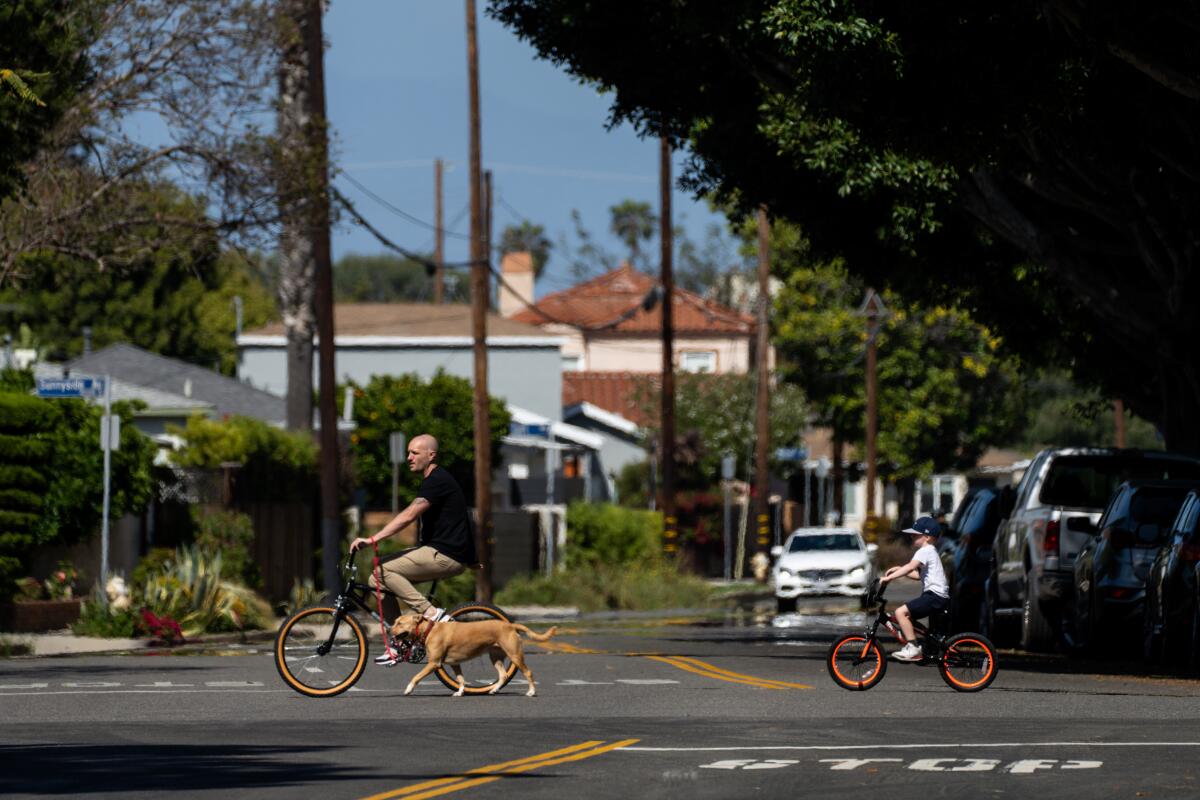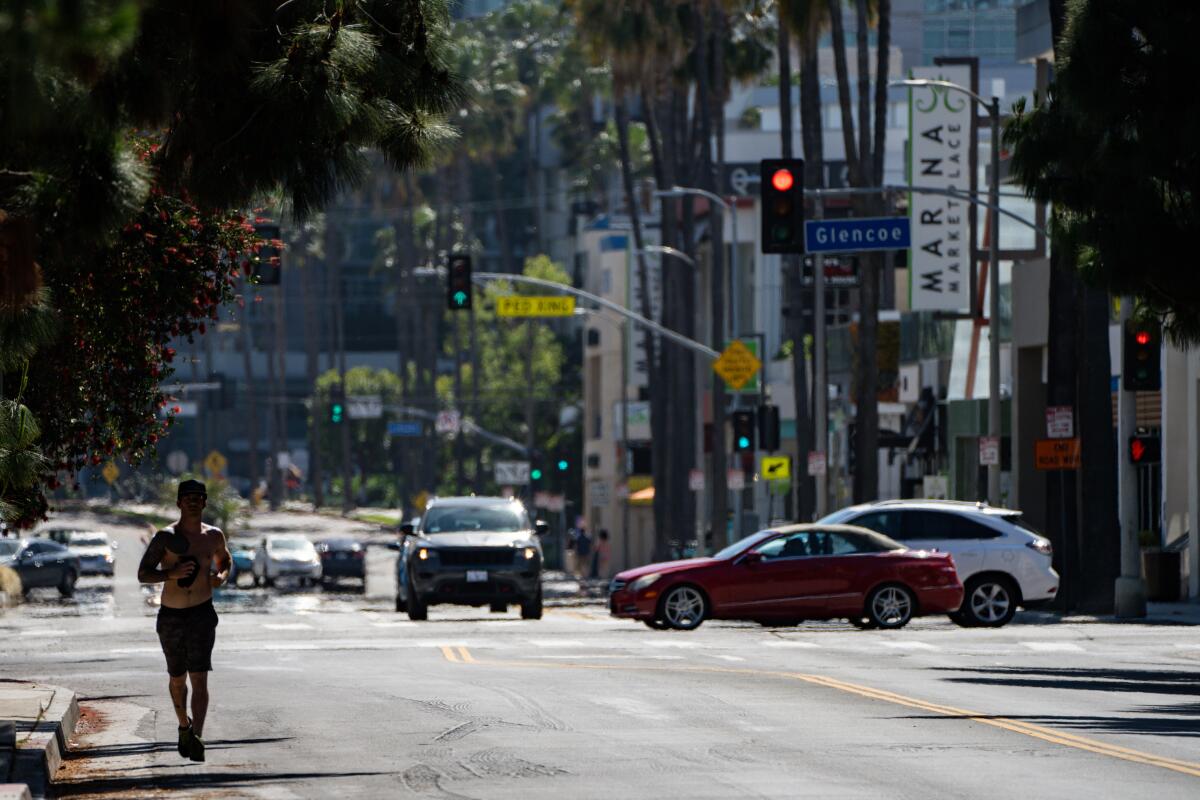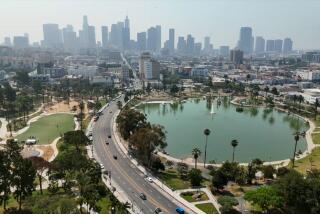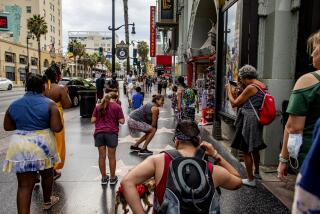Cities are opening streets to pedestrians during the pandemic. L.A. officials say it’s risky

- Share via
Last week, the Del Rey Neighborhood Council shared some big news: Starting the next day, traffic would be restricted on about a dozen residential streets in the Westside area to give residents more space to exercise.
Hours later, Los Angeles city officials told the group that the project was on hold. Neighborhood council President Matt Wersinger spent the evening sending glum responses on Twitter to those who’d celebrated the planned street closures.
When one person responded, “April Fool’s came late this year,” Wersinger responded: “Seems so.”
The postponement was a blow to Los Angeles residents who have been pushing officials to follow the example of more than two dozen other U.S. cities — including New York, San Diego, San Francisco and Oakland — that have created space for people to walk, bike and jog at a safe distance during the coronavirus pandemic.
The delay was also a fresh disappointment for advocates who have said that Mayor Eric Garcetti and his administration have failed to change the city’s car culture.
Advocates had hoped that the “soft closure” of streets in Del Rey, home to about 33,000 people, could be the first step in a citywide effort to create more space for residents to exercise outside.
As access to parks, hiking trails and beaches has been restricted, and as traffic levels have dropped, cooped-up residents have used local streets to jog, dance, ride bikes, rollerblade and play catch.

Sidewalks have become so crowded in the evenings that Del Rey residents have been forced into the street to maintain social distancing guidelines, Wersinger said, adding: “It’s very important for people’s mental health that they get out safely.”
Asked about what other cities have done, Garcetti said Wednesday that he was “very supportive” of limiting traffic on some L.A. streets. But, he said, it was important to listen to Los Angeles County health officials and not “jump the gun.”
Garcetti said he had spoken with Department of Public Health Director Barbara Ferrer and that she did not support open-streets projects “at the neighborhood level at this point.”
“It could draw too many people to one area — it could be something that spreads the disease,” Garcetti said. “So we have to be extremely thoughtful, extremely careful about it.”
Los Angeles City Councilman Mike Bonin, who represents Del Rey, voiced frustration Friday about the postponement of the neighborhood’s plan. Bonin said he believes that health officials mistakenly thought that Del Rey was proposing a program similar to CicLAvia, an event that shuts down major boulevards and draws thousands of people.
The Del Rey proposal isn’t a “massive, regional” event, Bonin said. “People from Silver Lake or Encino weren’t going to come to Glencoe Avenue in Del Rey to take a walk.”
A health department spokesperson did not respond when asked about the Del Rey proposal.
Ferrer said last week that she knows neighborhoods want more open space and that any such street closures should be done on a coordinated, countywide basis.
“We just want to do it in a thoughtful way,” Ferrer said.
That caution is shared by a handful of other local officials across the U.S., including Washington, D.C., Mayor Muriel Bowser. On a radio program last month, Bowser said she didn’t “want to send the message to people to go out and have a festival.”
Still, Bowser moved to temporarily extend sidewalks near grocery stores and other essential retailers to give people more room and allow them to comply with social distancing rules. She also has announced the closure of roads in some parks so residents have more space to walk, run and bike.
The best way to guard against crowding on a handful of streets is providing enough space to exercise near their homes, said Michael Schneider, founder of Streets For All, a nonprofit that advocates for bus lanes and bike lanes in Los Angeles
“It can’t be one or two spots,” Schneider said. “It has to be done in many parts of the city.”
Schneider said his group wants to restrict traffic on up to 400 miles of streets across the city, about two to four miles per neighborhood council district.
In Del Rey, officials planned to install signs at intersections to warn about the closures. The dozen or so “soft-closed” streets would have remained open to residents with cars, as well as delivery trucks and emergency vehicles, Wersinger said. Parking restrictions would remain the same, he said.
Oakland officials say they have closed 74 miles, or nearly 10%, of the city’s streets to outside traffic. New York Mayor Bill de Blasio’s office set a goal of 100 miles of closures, sidewalk widening and additional bike lanes, focusing on communities most affected by the pandemic.
Seattle’s program, which has opened nine miles of residential streets and plans to open 11 more, has been so successful that officials are considering making the changes permanent, said Department of Transportation Director Sam Zimbabwe.
City officials started opening streets April 17 to encourage people to walk, jog and exercise in their own communities, rather than get in the car and drive to a park. Zimbabwe said the program adheres to health guidelines, saying: “It’s not a block party.”
The outbreak has disproportionately hit low-income residents, with those living in such communities more likely to die of the disease than those in wealthier communities.
Locally, some of the areas with the highest death rates also lead the nation in levels of overcrowding, including Pico-Union and Westlake where more than a third of housing units are crowded — meaning there is more than one person per room, excluding bathrooms.
At Beethoven Street and Maxella Avenue in Del Rey, one street considered for a soft closure, pedestrians and joggers could be seen last week weaving into the street to avoid one another. Usually, the quiet area is teeming with cut-through traffic, residents said.
Mike Brady is staying with friends in Del Rey and walks six to seven miles a day. The streets are fairly empty, he said, but he crosses into them to avoid walking by strangers on the sidewalk.
“I don’t think it’ll make much difference,” Brady said of the potential street closures.
Bonin said he plans to write a letter to county health officials to explain the Del Rey program.
“Folks are really disappointed, particularly, because so many other cities are doing this,” Bonin said. “People here are saying, ‘Why can’t we do the same?’”
More to Read
Sign up for Essential California
The most important California stories and recommendations in your inbox every morning.
You may occasionally receive promotional content from the Los Angeles Times.












